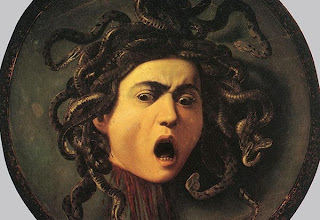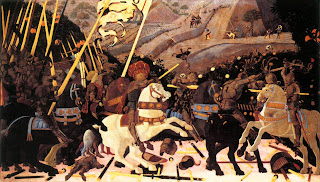 |
|
Painter Caravaggio
-Original was Lost |
Medusa’s Shield has been lost in
time but is one of those mysterious Leonardo da Vinci works with a high
level of spirit and debate. Originally painted in his youth an art historian
Giorgio Vasari made the account in 1550 that the painting was so realistic it
frightened both Leonardo’s father as well as others. It was seen as associated
with death and was secretly sold to merchants.
Vasari indicates that the face was
painted on a wooden shield cut from fig trees. It was a favor to a peasant
friend of his who fashioned the shield. Leonardo in his experimental style took
the shield and heated it by fire and made it smooth. He then moved to make one
his very first masterpieces.
When his father Ser Piero came see the shield and knocked on the door Leonardo told
him to wait. He took the painting and adjusted it near a window with the soft
light peering through. Ser Piero came in and took a look at the painting and
stepped back with a gasp. Leonardo said, “This work serves the end for which it
was made; take it, then, and carry it away, since this is the effect that it
was meant to produce.”
It is believed that the painting made its way
to the Duke
of Milan who held it for a while and then sold it again for 3X what he paid for
it. Medusa was part of Greek Mythology. She was seen as a protector who was
sexually forced by Poseidon and in Athena’s rage she took the “fair cheeked
Medusa” and turned her hair into snakes and her skin into scales so that all
men would hate her. Her very look would turn a man to stone.
To
historians and lay people Medusa represents many different things. To some she
is an example of female rage and the victim of lust and jealousy. To Freud it
was a sense of castration while to others it means scientific determinism.
Scientific determinism indicates that under the exact same conditions the same
thing would happen again and again. Regardless of the interpretations, Medusa is
an interesting character to both Leonardo and the world as it took Perseus’s
wit to eventually behead her making it an important story of history.
